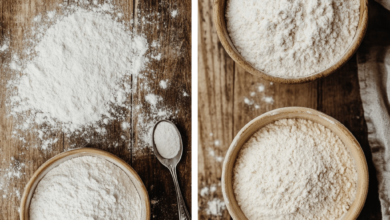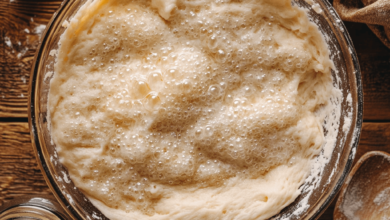What Is the Difference Between Baking Soda and Baking Powder?

Introduction
If you’ve ever wondered whether baking soda and baking powder are interchangeable, you’re not alone. These two ingredients are essential in baking, but they serve different purposes. What is the difference between baking soda and baking powder, and when should you use each? Let’s break it down to help you bake with confidence.
1. What Is Baking Soda?
Baking soda, also known as sodium bicarbonate, is a chemical compound that acts as a leavening agent:
- How It Works: Baking soda requires an acidic ingredient (like lemon juice, vinegar, or buttermilk) to activate. This reaction produces carbon dioxide bubbles, making your baked goods rise.
- Common Uses: Cookies, pancakes, and recipes with acidic ingredients.
2. What Is Baking Powder?
Baking powder contains baking soda along with an acid (like cream of tartar) and a stabilizer (like cornstarch):
- How It Works: Baking powder is double-acting, meaning it activates twice—once when mixed with wet ingredients and again when exposed to heat.
- Common Uses: Cakes, muffins, and recipes without naturally acidic ingredients.
3. Key Differences Between Baking Soda and Baking Powder
| Feature | Baking Soda | Baking Powder |
|---|---|---|
| Composition | Sodium bicarbonate | Baking soda + acid + stabilizer |
| Activation | Requires acidic ingredient | Activates with liquid and heat |
| Leavening Power | Stronger, needs precise measurement | Milder, easier to use in recipes |
| Uses | Recipes with acidic ingredients | Recipes without acidic ingredients |
4. When to Use Baking Soda vs. Baking Powder
- Use baking soda when your recipe includes acidic ingredients like buttermilk, yogurt, or lemon juice.
- Use baking powder for recipes that don’t include acidic ingredients, as it contains its own acid.
5. Can You Substitute One for the Other?
While it’s best to use what the recipe calls for, here are some tips for substitution:
- Substituting Baking Soda for Baking Powder: Use 1/4 teaspoon baking soda + 1/2 teaspoon cream of tartar for each teaspoon of baking powder.
- Substituting Baking Powder for Baking Soda: Use three times the amount of baking powder, but this may alter the flavor.
6. Common Mistakes to Avoid
❌ Using Too Much Baking Soda: Can leave a bitter, soapy taste.
❌ Using Expired Products: Baking soda and powder lose effectiveness over time.
❌ Ignoring Measurements: Proper measurement is key for desired results.
7. How to Test Freshness
- Baking Soda: Mix 1/4 teaspoon with vinegar. If it fizzes, it’s fresh.
- Baking Powder: Mix 1/4 teaspoon with water. If it bubbles, it’s fresh.
Conclusion
Baking soda and baking powder are essential leavening agents that work in different ways. Understanding their differences and when to use them can elevate your baking skills and ensure perfect results. For more kitchen insights, visit our Kuestion.com.




